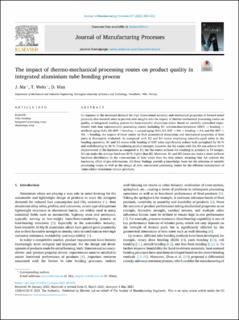| dc.contributor.author | Ma, Jun | |
| dc.contributor.author | Welo, Torgeir | |
| dc.contributor.author | Wan, Di | |
| dc.date.accessioned | 2021-05-21T13:09:24Z | |
| dc.date.available | 2021-05-21T13:09:24Z | |
| dc.date.created | 2021-05-18T08:59:01Z | |
| dc.date.issued | 2021 | |
| dc.identifier.citation | Journal of Manufacturing Processes. 2021, 67 503-512. | en_US |
| dc.identifier.issn | 1526-6125 | |
| dc.identifier.uri | https://hdl.handle.net/11250/2756067 | |
| dc.description.abstract | This study was conducted to provide a better understanding of the role of electric field strength in the production of aftereffects in resting state scalp electroencephalography by repetitive transcranial magnetic stimulation (rTMS) in humans. We conducted two separate experiments in which we applied rTMS over the left parietal-occipital region. Prospective electric field simulation guided the choice of the individual stimulation intensities. In the main experiment, 16 participants received rhythmic and arrhythmic rTMS bursts at between ca. 20 and 50 mv/mm peak absolute electric field intensities. In the control experiment, another group of 16 participants received sham rTMS. To characterize the aftereffects, we estimated the alpha power (8–14 Hz) changes recorded in the inter-burst intervals, i.e., from 0.2 to 10 s after rTMS. We found aftereffects lasting up to two seconds after stimulation with ca. 35 mV/mm. Relative to baseline, alpha power was significantly reduced by the arrhythmic protocol, while there was no significant change with the rhythmic protocol. We found no significant long-term, i.e., up to 10-second, differences between the rhythmic and arrhythmic stimulation, or between the rhythmic and sham protocols. Weak arrhythmic rTMS induced short-lived alpha suppression during the inter-burst intervals. | en_US |
| dc.language.iso | eng | en_US |
| dc.publisher | Elsevier | en_US |
| dc.rights | Attribution-NonCommercial-NoDerivatives 4.0 Internasjonal | * |
| dc.rights.uri | http://creativecommons.org/licenses/by-nc-nd/4.0/deed.no | * |
| dc.title | The impact of thermo-mechanical processing routes on product quality in integrated aluminium tube bending process | en_US |
| dc.type | Peer reviewed | en_US |
| dc.type | Journal article | en_US |
| dc.description.version | publishedVersion | en_US |
| dc.source.pagenumber | 503-512 | en_US |
| dc.source.volume | 67 | en_US |
| dc.source.journal | Journal of Manufacturing Processes | en_US |
| dc.identifier.doi | http://dx.doi.org/10.1016/j.jmapro.2021.05.015 | |
| dc.identifier.cristin | 1910377 | |
| dc.description.localcode | Open Access. © 2021 The Author(s). Published by Elsevier B.V. | en_US |
| cristin.ispublished | true | |
| cristin.fulltext | original | |
| cristin.qualitycode | 1 | |

